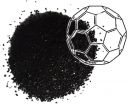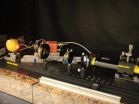(Press-News.org) The first scientific evidence of frankincense being used in Roman burial rites in Britain has been uncovered by a team of archaeological scientists led by the University of Bradford. The findings - published today in the Journal of Archaeological Science - prove that, even while the Roman Empire was in decline, these precious substances were being transported to its furthest northern outpost.
The discovery was made by carrying out molecular analysis of materials previously thought to be of little interest - debris inside burial containers and residues on skeletal remains and plaster body casings. Until now, evidence for the use of resins in ancient funerary rites has rarely come to light outside of Egypt.
The samples came from burial sites across Britain, in Dorset, Wiltshire, London and York, dating from the third to the fourth century AD. Of the forty-nine burials analysed, four showed traces of frankincense - originating from southern Arabia or eastern Africa - and ten others contained evidence of resins imported from the Mediterranean region and northern Europe.
Classical texts mention these aromatic, antimicrobial substances as being used as a practical measure to mask the smell of decay or slow decomposition during the often lengthy funeral rites of the Roman elite. But it was their ritual importance which justified their transportation from one end of the empire to the other. Seen both as gifts from the gods and to the gods, these resins were thought to purify the dead and help them negotiate the final rite of passage to the afterlife.
Rhea Brettell from the University of Bradford, whose research is funded by the Arts and Humanities Research Council, was the first to realise that these grave deposits were an untapped reservoir of information which could provide the missing evidence:
"Archaeologists have relied on finding visible resin fragments to substantiate the descriptions of burial rites in classical texts, but these rarely survive," she says. "Our alternative approach of analysing grave deposits to find the molecular signatures of the resins - which fortunately are very distinctive - has enabled us to carry out the first systematic study across a whole province."
These resins were only recovered from burials of higher status individuals, identified from the type of container used, the clothing they were wearing and items buried with them. This is consistent with the known value of frankincense in antiquity and the fact it had to be brought to Britain via what, at the time, was a vast and complex trade route.
University of Bradford Professor of Archaeological Sciences, Carl Heron, who led the research, adds: "It is remarkable that the first evidence for the use of frankincense in Britain should come from such seemingly unpromising samples yet our analysis demonstrates that traces of these exotic resins can survive for over 1700 years in what others would reject as dirt."
The project was a collaboration between the University of Bradford and specialists at the Anglo-Saxon Laboratory in York, the Museum of London and the Universities of Bamburg and Bordeaux.
Dr Rebecca Redfern, research osteologist in the Centre for Human Bioarchaeology at the Museum of London, said: "This eye opening study has provided us with new and amazing insights into the funerary rituals of late Roman Britain. The University of Bradford's significant research has also rewarded us with further understanding of a rich young Roman lady, used in the study, whose 4th century skeleton and sarcophagus was discovered near Spitalfields Market in the City of London in 1999, making her burial even more unique in Britain."
INFORMATION:
The materials from which the samples were collected are held by Dorset County Museum, Museum of London, Swindon Museum and Art Gallery, Wessex Archaeology, Winchester Museums and York Museums Trust.
The resins found in the study were from three different plant families:
Pistacia spp. (mastic/terebinth) from the Mediterranean or the Levant
Pinaceae (probably Pinus spp.) from Northern Europe
Boswellia spp. (frankincense/olibanum) from southern Arabia and eastern Africa
This study published in Journal of Archaeological Science covers inhumation burials. The University of Bradford researchers have subsequently also identified resins in a cremation burial from the Mersea Island barrow, where the resins were added to the ashes in the urn prior to burial. These findings are due to be published in the New Year.
Vienna, Austria - 04 December 2014: Non-ergot derived dopamine agonists used to treat Parkinson's disease may be safe for the heart, according to preliminary research presented at EuroEcho-Imaging 2014 by Dr Hilal Erken Pamukcu, cardiologist at Ankara Diskapi Education and Research Hospital in Turkey.
EuroEcho-Imaging is the annual meeting of the European Association of Cardiovascular Imaging (EACVI), a registered branch of the European Society of Cardiology (ESC), and is held 3-6 December in Vienna, Austria.
Dr Erken Pamukcu said: "Parkinson's disease is a neurological ...
Many patients with first-episode psychosis receive medications that do not comply with recommended guidelines for first-episode treatment, researchers have found. Current guidelines emphasize low doses of antipsychotic drugs and strategies for minimizing the side effects that might contribute to patients stopping their medication. A study finds that almost 40 percent of people with first-episode psychosis in community mental health clinics across the country might benefit from medication treatment changes.
Psychosis is a mental disorder in which thoughts and emotions ...
It has been a long held belief that tumors arising from exposure to asbestos are caused by mutations in one cell, which then produces multiple clones. This hypothesis is challenged by new research published in the open access Journal of Translational Medicine, which suggests it is caused by mutations in multiple cells.
Malignant mesothelioma is a rare form of cancer that affects the mesothelium - the protective lining that covers the internal organs, such as the lungs, the heart and the abdominal cavity. It is estimated that malignant mesothelioma affects up to 3,200 ...
Some previous studies have linked the diabetes medication pioglitazone to bladder cancer. However a new study − including more than one million people in six populations worldwide − has found no link between either pioglitazone or rosiglitazone (also known as Avandia) and bladder cancer. The new study is published in Diabetologia (the journal of the European Association for the Study of Diabetes), and is by Dr Samira Bell, Professor Helen Colhoun and Mr Danny Levin, University of Dundee, UK, and colleagues from the International Diabetes and Cancer Research ...
Children born prematurely are at an increased risk of flu-related complications, despite not being identified as an "at risk" group in UK, USA, or WHO guidelines, and should be a priority group for the seasonal flu vaccination, new research published in The Lancet Respiratory Medicine suggests.
"Until now, guidelines highlighting groups at greater risk of developing complications from influenza, such as pneumonia, have been based on consensus opinion rather than on systematic assessment of the evidence"*, explains Dr Kay Wang from the University of Oxford in the UK. ...
Researchers at the National Institutes of Health have found a duplication of a short stretch of the X chromosome in some people with a rare disorder that causes excessive childhood growth. They believe that a single gene within the region likely has a large influence on how much children grow. The research comes from a lab at NIH's Eunice Kennedy Shriver National Institute of Child Health and Human Development (NICHD), which seeks to understand growth.
"Finding the gene responsible for childhood overgrowth would be very helpful, but the much wider question is what ...
HOUSTON - (Dec. 3, 2014) - Rice University scientists have discovered an environmentally friendly carbon-capture method that could be equally adept at drawing carbon dioxide emissions from industrial flue gases and natural gas wells.
The Rice lab of chemist Andrew Barron revealed in a proof-of-concept study that amine-rich compounds are highly effective at capturing the greenhouse gas when combined with carbon-60 molecules.
The research is the subject of an open-access paper today in Nature's online journal Scientific Reports.
"We had two goals," Barron said. "One ...
The longer surgery lasts the more prone patients appear to be to develop blood clots (venous thromboembolisms, VTE), according to a report published online by JAMA Surgery.
The association between longer surgical procedures and death, including VTE, is widely accepted but it has yet to be quantitatively addressed. More than 500,000 hospitalizations and 100,000 deaths are associated each year with VTEs. Examining the link between VTE and surgical time could allow for more informed medical and surgical decisions, according to the study background.
John Y.S. Kim, M.D., ...
CHICAGO --- The longer the duration of surgery, the higher the risk of a life-threatening blood clot, according to the first large-scale, quantitative national study of the risk across all surgical procedures.
The Northwestern Medicine study was published Dec. 3 in JAMA Surgery, the Journal of the American Medical Association.
The finding will help guide surgical decision-making by enabling surgeons and patients to better understand the potential risk of procedures. These findings may also spur surgeons to take more aggressive preventative measures such as giving ...
WASHINGTON, Dec. 3, 2014--The ability to detect when to harvest "climacteric" fruits -- such as apples, bananas, pears and tomatoes -- at the precise moment to ensure "peak edibleness" in terms of both taste and texture may soon be within reach for farmers, thanks to the work of a team of researchers from Saint Joseph University in Lebanon and the Université de Bretagne Occidentale de Brest in France.
As the team reports in a paper published in The Optical Society's (OSA) journal Applied Optics, they recently demonstrated a laser biospeckle technique capable of detecting ...


